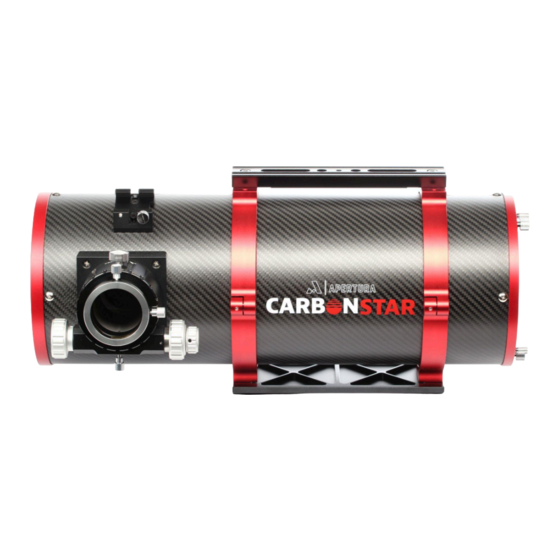
Advertisement
Advertisement
Table of Contents

Summary of Contents for Apertura Carbon Star 150
- Page 1 Carbon Star 150 Imaging Newtonian User’s Manual By Matthew M Paul 2024...
-
Page 2: What's Included
What’s Included 1- Optical Tube Assembly (OTA) 2- Front Dust Cover 3- Primary Cell Cover 4- Tube Rings 5- V Style Bar 6- D Style Bar 7- 1.25” to 2” Adapter 8- M6 x 18mm Cap Head Screws 9- 5mm Hex Key 10- 2.5mm Hex Key Specifications Model Number:... - Page 3 The following chart shows the measured field illumination of the Carbon Star 150 Imaging Newtonian when compared to the older Apertura 6F4N. There is roughly a 10% gain in signal at the center of field which gently tapers to the extreme corners of an IMX294 sensor. The blue line...
- Page 4 Apertura has addressed this problem by building the carbon fiber optical tube around nine knife edge baffles. These baffles control stray light by blocking internal reflections and reducing its ability to reach the focal plane.
- Page 5 Mounting Hardware Premium CNC machine aluminum tube rings and multiple dovetail bar offerings allow this telescope to be attached to nearly any modern equatorial mount. The tube rings have an inside diameter of 178mm. On the top and bottom of the rings, there are three M6 x 1.0 threaded holes: One hole being centrally located, and the outer holes having a 55mm separation from each other, center-to-center.
- Page 6 Focuser The Carbon Star Imaging Newtonian has an all new focuser! It is a linear bearing focuser which is strong and can support a cooled astronomy camera, electronic filter wheel, off axis guider, and coma corrector. What exactly is a linear bearing focuser? This focuser design is similar to a Crayford but uses a 100mm long rail which is supported by dozens of precision ball...
-
Page 7: Assembling The Telescope
Assembling the Telescope Using the two included V and D-series dovetail bars, the telescope can be configured in a variety of ways. Depending on the mount that the telescope will be attached to, one dovetail bar might be more beneficial than the other. -
Page 8: Using The Telescope
Using the Telescope Coma Corrector We highly recommend using this telescope with the Apertura Photographic Reducing Coma Corrector, though the telescope will work with most other coma correctors on the market. This manual will cover how to use the telescope with the PRCC. Other coma correctors will follow a similar process. - Page 9 The Apertura PRCC has a back focus of 55mm and an M48 mounting thread. This makes attaching your camera to the M48 threads on the Apertura Photograph Reducing Coma Corrector a breeze. Focusing When using this PRCC with the Carbon Star 150mm Imaging Newtonian, the telescope will focus around the 20mm mark on the focuser’s drawtube.
- Page 10 EAF Installation 1. Remove the coarse focus knob by 4. Slide the 5mm Adapter and EAF loosening the internal set screw over the focuser’s protruding shaft using a 2mm hex key. and gently start the screws which connect the focuser to the bracket, they will be M4.
- Page 11 7. Tighten the two remaining focuser 9. Optional: Rotate focuser 90-deg. to motor bracket to Focuser block more easily allow the use of a flat screws. panel. a. Support the focuser so that it does not fall or become damaged when the screws are loosened.
-
Page 12: Maintenance
Apertura 1.25" Laser Collimator with 45-deg Angled Face Apertura Cheshire Collimation Eyepiece are the two tools that we recommend. - Page 13 Laser Collimation For an initial and speedy collimation check the laser is used. Remove the front dust cover from the telescope. Insert the laser into the focuser and turn it on. Adjust the secondary mirror screws at the front of the telescope so the laser beam centers on the spot of the primary mirror. Then, unlock the primary mirror locking screws by loosening them.
- Page 14 Apertura Cheshire Collimation Eyepiece, please see the following AstronomyHUB article: Collimating a Newtonian Telescope with the Apertura Cheshire Collimating Eyepiece. Perfecting the Primary Mirror Collimation with a Star Test It is possible for the collimation to be checked in an even more precise method, though it should be noted that this is generally considered to be an “over the top”...
- Page 15 to move the optical axis to the center of the field of view. This is, in essence, exactly what we are doing when we collimate a telescope. We adjust the mirrors so the optical axis of the telescope coincides with the center of our field of view within the focuser, whether that be an eyepiece or a camera.
-
Page 16: Warranty
Warranty The Apertura Absolute Warranty provides two years of coverage against product defects. After the initial two-year warranty expires, this product qualifies for Apertura's Three-Year Accident Replacement Program. In addition, the Apertura Absolute Warranty is transferable! It is important to keep your original receipt and the product's original boxes and packaging, should...






Need help?
Do you have a question about the Carbon Star 150 and is the answer not in the manual?
Questions and answers